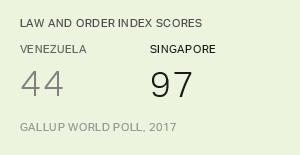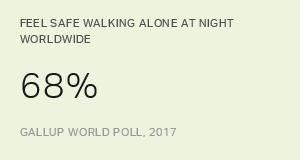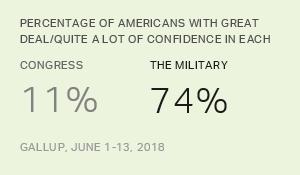This is the second in a two-part series that looks at perceptions of safety from different groups of Americans in contrast to perceptions of safety around the world.
Based on Gallup's data about people's perceptions of their own safety and their experiences with law enforcement, we know that Americans from different racial and socioeconomic backgrounds don't share the same sense of security. There are significant disparities. We find the same is true for men and women.
Looking deeper into two key factors of Gallup's Law and Order Index, feeling safe walking alone at night in the area you live in and confidence in local police, we see that important subgroups of American men and women may feel only as safe as people in countries that Americans may perceive as more dangerous than their own.
Worldwide in 2017, men report higher perceptions of personal safety (75%) than women (61%). Despite this global gender gap in perceptions of safety, some Americans experience more extreme differences by gender than others.
To illustrate this point, 52% of women in Nigeria and 60% of men in Guatemala report feeling safe walking alone at night in the city or area where they live. The percentages are the same for nonwhite American women (52%) and men (60%) living in households making $48,000 a year or less in the U.S.
Overall and at every income level in the U.S., men (85%) feel safer than women (64%), with just over half of the lowest-income women (55%) feeling safe to walk alone at night. Despite this gender gap in perceptions of safety, overall, American women report the same high level of confidence in local police that men do.
| Men | Women | Safety gap | ||||||||||||||||||||||||||||||||||||||||||||||||||||||||||||||||||||||||||||||||||||||||||||||||||
|---|---|---|---|---|---|---|---|---|---|---|---|---|---|---|---|---|---|---|---|---|---|---|---|---|---|---|---|---|---|---|---|---|---|---|---|---|---|---|---|---|---|---|---|---|---|---|---|---|---|---|---|---|---|---|---|---|---|---|---|---|---|---|---|---|---|---|---|---|---|---|---|---|---|---|---|---|---|---|---|---|---|---|---|---|---|---|---|---|---|---|---|---|---|---|---|---|---|---|---|---|
| % | % | pct. pts. | ||||||||||||||||||||||||||||||||||||||||||||||||||||||||||||||||||||||||||||||||||||||||||||||||||
| Household income | ||||||||||||||||||||||||||||||||||||||||||||||||||||||||||||||||||||||||||||||||||||||||||||||||||||
| $24,000 or less | 76 | 55 | 21 | |||||||||||||||||||||||||||||||||||||||||||||||||||||||||||||||||||||||||||||||||||||||||||||||||
| $24,001 to $48,000 | 84 | 68 | 16 | |||||||||||||||||||||||||||||||||||||||||||||||||||||||||||||||||||||||||||||||||||||||||||||||||
| $48,001 to $72,000 | 89 | 72 | 17 | |||||||||||||||||||||||||||||||||||||||||||||||||||||||||||||||||||||||||||||||||||||||||||||||||
| $72,001 to $108,000 | 90 | 78 | 12 | |||||||||||||||||||||||||||||||||||||||||||||||||||||||||||||||||||||||||||||||||||||||||||||||||
| $108,001 and above | 91 | 72 | 19 | |||||||||||||||||||||||||||||||||||||||||||||||||||||||||||||||||||||||||||||||||||||||||||||||||
| Gallup World Poll | ||||||||||||||||||||||||||||||||||||||||||||||||||||||||||||||||||||||||||||||||||||||||||||||||||||
Gender Gap Differs by Income and Race
Racial differences in perceptions of safety between white and nonwhite Americans are sometimes attributed to income levels. Gallup data show that even among low-income households, racial differences in both perceptions of safety and confidence in the police are substantial. With women in the U.S. generally expressing lower perceptions of safety, it is not surprising that low-income nonwhite women would be particularly vulnerable.
Nonwhite women are less likely than white women, 54% vs. 66%, to feel safe walking alone at night. Similarly, nonwhite men are less likely to feel safe walking at night in their communities (71%) compared with white men (88%).
Among nonwhite households making $48,000 or less a year, women have a lower sense of safety, with 52% reporting feeling safe walking alone at night, compared with 60% of nonwhite men. Among low-income white adults, women have a lower sense of safety (61%) compared with men (85%).
Despite the lower perceptions of safety that lower-income white women report (61%), they hold the same perceptions of safety in their communities that low-income nonwhite men experience (60%). This is shocking in the U.S., where there is about a 20-percentage-point gap between men and women overall and at most income categories, until you look at race.
White men in the lower-income group are relatively insulated from any drop in perceptions of safety, whereas nonwhite men experience perceptions of safety that are more similar to those of low-income white women. The safety perception gap is smallest among lower-income nonwhite households -- only eight points, compared with the 24 points separating lower-income white men and women.
| Men | Women | Safety gap | |||||||||||||||||||||||||||||||||||||||||||||||||||||||||||||||||||||||||||||||||||||||||||||||||
|---|---|---|---|---|---|---|---|---|---|---|---|---|---|---|---|---|---|---|---|---|---|---|---|---|---|---|---|---|---|---|---|---|---|---|---|---|---|---|---|---|---|---|---|---|---|---|---|---|---|---|---|---|---|---|---|---|---|---|---|---|---|---|---|---|---|---|---|---|---|---|---|---|---|---|---|---|---|---|---|---|---|---|---|---|---|---|---|---|---|---|---|---|---|---|---|---|---|---|---|
| % | % | pct. pts. | |||||||||||||||||||||||||||||||||||||||||||||||||||||||||||||||||||||||||||||||||||||||||||||||||
| Whites with $48,000 or less annual household income | 85 | 61 | 24 | ||||||||||||||||||||||||||||||||||||||||||||||||||||||||||||||||||||||||||||||||||||||||||||||||
| Nonwhites with $48,000 or less annual household income | 60 | 52 | 8 | ||||||||||||||||||||||||||||||||||||||||||||||||||||||||||||||||||||||||||||||||||||||||||||||||
| Whites with more than $48,000 annual household income | 91 | 79 | 12 | ||||||||||||||||||||||||||||||||||||||||||||||||||||||||||||||||||||||||||||||||||||||||||||||||
| NOTE: Insufficient sample sizes for reporting nonwhite respondents by gender for more than $48,000 annual income | |||||||||||||||||||||||||||||||||||||||||||||||||||||||||||||||||||||||||||||||||||||||||||||||||||
| Gallup World Poll | |||||||||||||||||||||||||||||||||||||||||||||||||||||||||||||||||||||||||||||||||||||||||||||||||||
Confidence in the Police
The strained relationship between police and nonwhite Americans is evident in the World Poll data about confidence in local police. Nonwhite men (68%) and nonwhite women (71%) report less confidence in local police than their white neighbors do (83% for men and 82% for women). Nonwhite men and women do not differ significantly in their confidence in local police; the same is true for white men and women.
Among Americans living in households making less than $48,000 a year, nonwhite Americans express less confidence in local police compared with white Americans (69% among nonwhites; 82% among whites). There are no gender differences within the racial groups on confidence in police.
Similar to the racial differences, Hispanic women (53%) report feeling safe at a lower rate than Hispanic men (78%). Both Hispanic men and women report perceptions of less relative safety compared with non-Hispanic women (65%) and non-Hispanic men (85%). But in contrast to the situation with race, there are no differences in confidence in police between Hispanics and non-Hispanics.
Bottom Line
The safety and security of women around the world is foundational for gender equality, a key Sustainable Development Goal for the United Nations. Among Americans who are living in lower-income households or are people of color, the perceptions of men and women illustrate the very different experiences that Americans have in their communities and with local law enforcement.
Law and order continues to be an important topic globally and here in the U.S., with these differences among important demographic groups shaping the way people perceive -- and therefore move and live in -- their environments. Reducing the perception gaps in safety between men and women, rich and poor, and nonwhite and white Americans is an important step to improving a sense of safety and security in the U.S. and creating equality for all.



